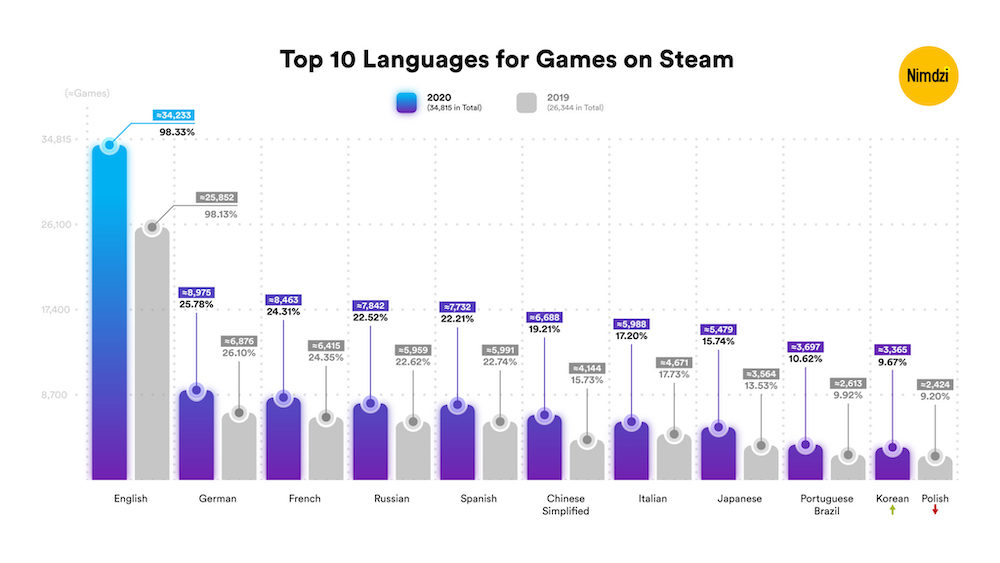The presence of a translation can increase the number of vishlist on Steam by 50%
Localization is an important issue, especially for small developers with a limited budget. In addition, the list of key PC markets has changed a lot in recent years – for example, Russian is now among the four most popular languages on Steam. Gaming expert Simon Carless told how localization can affect sales, and what rules should be followed in this matter.At the beginning of his material, Carless draws attention to last year’s research by the marketing firm Nimdzi.
Analysts compared data for 2019 and 2020 to understand which languages are the most popular on Steam today.
Several markets that were traditionally considered important for games have lost their positions. For example, Russian has overtaken Spanish, and simplified Chinese has overtaken Italian. Also, Korean has displaced Polish from the top 10.Top 10 most popular languages on Steam for 2019 and 2020Of course, English remains the most widely spoken language.
However, in order to increase coverage and reach other markets, it is necessary to localize games for users of other countries.
It seems logical to translate into Chinese, since the Chinese market on Steam is on the rise, and the presence of localization will allow access to millions of users. In addition, a much smaller number of games presented in the Chinese store can be a great advantage, which can also have a positive effect on findability.
Ideally, you can translate the game into as many languages as possible. However, it is not always financially feasible, and therefore the localization process is a much more complex issue.
Key rulesPlan localization as early as possible.
- Even a simple translation of the game page before the release into different languages can increase the project’s findability in the future and increase coverage during Steam festivals.Abandon the old EFIGS formula (English, French, Italian, German, Spanish).
- Previously, most developers were limited to translating only into these languages, since they were considered the main ones. However, today, especially on PC, completely different markets are gaining popularity — for example, Chinese.Think carefully about your budget if there is a lot of text in the game.
- Professional translation of a game with tens of thousands of words into several languages can cost a six-figure sum. Therefore, before localization, it is necessary to understand how much additional transfers will be profitable from a financial point of view.Consider the possibility of crowdsourcing transfers — for example, on sites like Localizer.
- They can help in translating the game into “exotic” languages, but it should be understood that the quality of localization may not be ideal. Firstly, users rarely undertake the translation of small games from unknown developers. Secondly, the quality of localization can sometimes be at the level of Google Translator.Experience of small publishing houses
Carless talked about localization of games with Chris Wright, the head of indie publisher Fellow Traveller.
“[Our company] gives priority to translation into those languages that open up new markets in which we would not be able to launch in the absence of localization,” he said.
According to Wright, the top five most financially profitable languages include simplified Chinese, Japanese (especially if the game also comes to the Nintendo Switch), traditional Chinese (this opens up the markets of Taiwan and Hong Kong), Russian and Brazilian Portuguese.For example, the translation of Fellow Traveller games into Chinese has increased the publisher’s revenue share in this market from 5% to 20%.
Tim Bender, CEO of the publisher Hooded Horse, also shared his experience. He analyzed the impact of translations on the number of vishlist, comparing the indicators before the localization announcement and after the appearance of the localized page on Steam.
“If we talk about French and German, about 60-65% of vishlists appeared regardless of the presence of localization, and the presence of translation directly affected 35-40% of vishlists. Thus, localization increased the number of vishlists by about 50%. In the case of Spanish, about 50% of Vishlist appeared due to localization, and in East Asian countries – over 90%,” Bender explained.
Carless comes to the conclusion that localization should not pay attention solely to the size of the market. The strategy of “Making a transfer only for those countries with the most players” is not always correct. It is best to pay attention to countries where there are fewer English-speaking users. As a result, this may increase sales the most in regions outside the United States.
